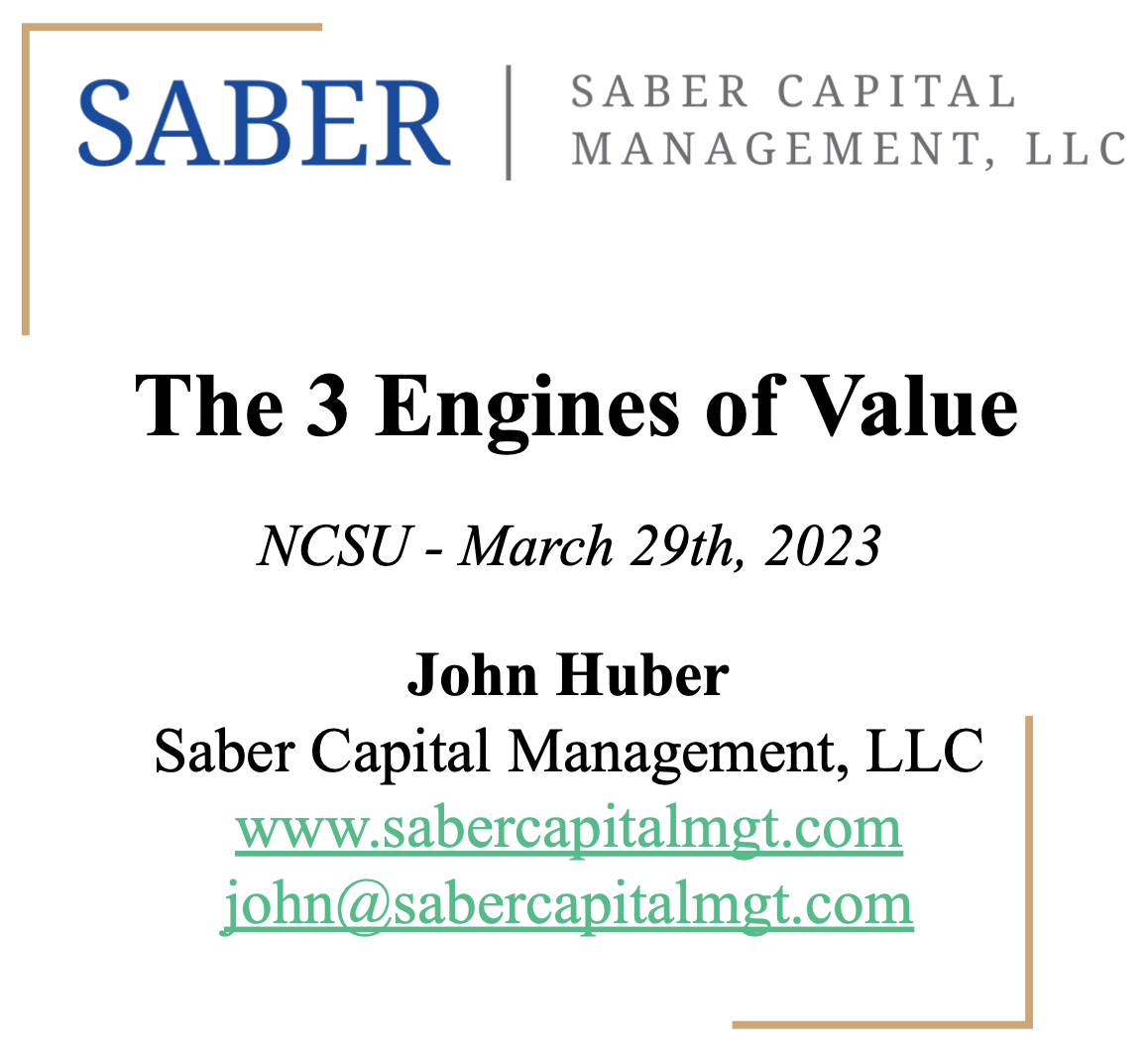I recently had a chance to give a guest lecture at NC State University to the students who run Bell Tower Capital Management, a student-managed investment fund. I really enjoyed the meeting. There are some high-quality investment professionals in the making at NCSU.
Q1 2023 hedge fund letters, conferences and more

The talk is called “The Three Engines of Value” (link below) — a topic I’ve touched on briefly in client letters over the years. It outline the 3 simple factors that drive each stock’s price over time:
- Earnings growth
- Change in P/E multiple
- Change in shares outstanding
One of the things that is often overlooked in the stock market is how valuable it is to have a low valuation. If your company is self funding (meaning, it doesn’t need to rely on a high stock price as currency to raise fresh funds to cover losses), then a low valuation is a blessing, not a curse. I see so many companies talking about their strategy to “get out multiple up”, but this is not beneficial to long term owners. To better understand why this is, it’s important to remember that there are three driver’s of value for each and every stock: Growth, the change in the valuation, and the change in the shares outstanding. So many people focus on the multiple, and certainly a stock that goes from say 10 to 20 times earnings over a decade has a nice 7% annual tailwind from that multiple expansion. But what many management teams often forget is that a low multiple can create more value over the long run than a one time bump in valuation.
In 2020, an intern and I completed a study of the best performing stocks from 2005 to 2020, which encompassed the financial crisis, a deep recession, an expansion, and the early days of Covid. Many attributes of these winners are obvious (such as secular tailwinds that led to huge sales growth). But, a number of stocks on the list were merely moderate growers which had something that the high fliers didn’t have: a cheap stock that persisted for many years. This gave the company the ability to consistently buy back shares at a high earnings yield. Basically, a stock that averaged 12 P/E for a long period of time is going to create far more long term value than if this same company traded at 30 P/E, because the market’s lower valuation allows the company to reduce far more shares than they otherwise would have. Apple at 10 P/E was a stock in 2016 that was going to create enormous value given their FCF yield (which was all getting returned to owners) plus the growth (which even at a modest rate of 8% still meant an 18% intrinsic growth rate per share). Apple’s P/E rose and pulled forward even more returns in the last 7 years, but some of the great all time winners were able to benefit from a multiple that didn’t rise, meaning this 18% rate could continue as long as the company’s modest sales growth rate of 8% lasted.
A number of winners on this list fit this general description: a modest but very consistent growth rate, a lot of free cash flow, and a persistently low to moderate P/E ratio. Some of the best stocks of the last quarter century including AutoZone, O’Reilly Auto Parts, and NVR never really have seen high multiples (part of the reason why their stocks continue to do so well even today). There are many others that are on this list, and there are a number of potential candidates that I believe will be the next decade’s crop of stealth compounders (those that aren’t growing at exciting rates but have strong moats, predictable businesses, free cash flow and shrinking share counts).
The lesson here, though, is to think about the three drivers and not get too focused on one at the expense of the other two. The best stocks over the very long term tend to have at least moderate growth (fast growth is nice but isn’t necessary, and sometimes can lead to poor capital allocation). But the winners also tend to have the other two engines working in their favor as well. In the talk, I outlined a few examples, starting with a quiz that a friend of mine once gave me that highlights the value of these three engines:

There is no recording to the meeting, but I gave this same basic presentation last fall at an online conference: link to video; password: d*nm+=c{(1f
Thanks for reading, and feel free to connect with any questions.

